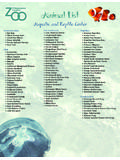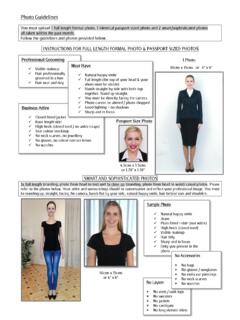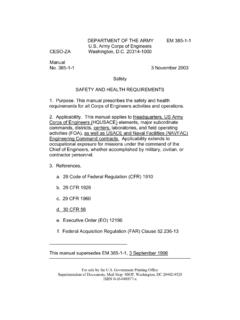Transcription of Lab - Tensile Testing and Strain Gauges - gatech.edu
1 Copyright 2015,2017 by M. Mello, J. Rimoli, G. Kennedy and J. Seitzman. All rights reserved. AE2610 Introduction to Experimental Methods in Aerospace Tensile Testing OF MATERIALS AND Strain Gauges Objectives This experiment is intended to explore the stress- Strain behavior of ductile metals subject to Tensile loads and to introduce transducers that are used in mechanical Testing . The Tensile test is the most basic structural test of a material and is used to characterize its response to structural loads. The characterization data obtained from a Tensile test is used directly for structural analysis and design. This experiment requires the use of several mechanical transducers that are used to measure the elongation of the specimen and the force applied by the load frame. As part of this lab, you will also be exposed to the physical principles that are used in these devices.
2 Safety Wear close-toed shoes in the lab to avoid injuries to your feet if you drop lab equipment, and the eye protection glasses supplied to you. This experiment also involves the use of chemical adhesives and solvents; so make sure to wash your hands after performing the lab. Background Stress and Strain A Tensile test is designed to experimentally characterize the relationship between stress and Strain . Stress and Strain are fundamental concepts in the study of mechanics of materials and we briefly summarize them here. Stress is a measure of the intensity of a force exerted over an area. In this test, we will measure axial or normal stress. Consider a prismatic bar with a cross-sectional area A0, loaded at both its ends with opposing forces with magnitude P, the stress in the bar is given by: 0AP=s (1) where s is the normal stress.
3 Stress has units of force per unit area, which in SI units are pascals [Pa] and in English units are pounds per square inch [psi]. Since the magnitude of stress can be large, it is common to use units of megapascals [MPa] and ksi ( , thousands of psi). Note that during the Tensile test, the cross-sectional area of the specimen will change; however, we will continue to normalize the force by the initial area. This is usually referred to as engineering stress. AE 2610 Tensile Testing and Strain Gauges 2 Strain is a measure of the elongation of the structure per unit length. Given a prismatic bar of initial length L0 and the elongation of the bar, d, under load, the normal Strain is given by: 0 Lde= (2) Since both d and L0 have dimensions of length, Strain is a dimensionless quantity. The length of the bar will change during the test, especially at high loads, but we will always use the initial bar length.
4 Tensile Testing Specimens: In this experiment, you will measure the Strain in a bar using a Strain gauge, and the elongation of the bar under load using an extensometer. These measurement devices are described in a later section. You will use aluminum that has been machined into a typical material specimen shape, specifically, a dog bone specimen, as shown in Figure 1. The shape of the specimen is designed to produce a uniform Tensile stress and Tensile Strain in the gauge region. If the specimen were to fail outside this region, in either the grip or shoulder areas, then the results from the test could not be used because stress and Strain in these regions is not uniform. The dog bone specimen is designed so that we can fasten the test machine to the grips at either end of the specimen to apply an axial load.
5 Stress- Strain Diagrams and Material Models: In this experiment, you will generate experimental stress- Strain diagrams. A sketch of a stress- Strain diagram for a generic ductile metal is shown in Figure 2. As engineers, we use mathematical approximations that are designed to model the measured stress- Strain response. Thus we can explore how closely these mathematical models match the measured stress- Strain diagram. Material models can be classified as either elastic or inelastic. An elastic response is one in which the loads on the structure are low enough so that no permanent deformation or damage to the specimen occurs. Once the loads are removed, the specimen returns to its original shape, and the experiment could be repeated to produce the same stress- Strain response. An inelastic response is one in which permanent deformation occurs, so that when the specimen is unloaded it returns to a different shape than the original specimen.
6 The simplest mathematical model of an elastic stress- Strain response is Hooke's Law. Hooke postulated a linear relationship between stress and Strain , written as follows: esE= (3) Here the proportionality constant, E, is called Young's modulus or the elastic modulus. Note that since the Strain is dimensionless, the Young's modulus has the same units as stress. Hooke's Law is often a good model for the stress- Strain relationship when the stress is below a threshold AE 2610 Tensile Testing and Strain Gauges 3 called the proportional limit, sp. Some ductile metals have a clearly defined proportional limit, others do not. Beyond the proportional limit, the material may still exhibit an elastic response but the relationship between stress and Strain is nonlinear. Another important point on the stress- Strain diagram is the yield stress, sy.
7 Above the yield stress, materials exhibit inelastic behavior where permanent inelastic deformation occurs, even when the load is removed. Again, this is a model of the response of a ductile metal, and some metals have a clearly defined yield point while others do not. In ductile metals, as the specimen enters the yielding regime it undergoes a large elongation without a large increase in stress. The slope of the stress- Strain diagram, called the stiffness, is much smaller than before yielding. As the yielding progresses, metals often exhibit Strain hardening (also called work hardening) where the stress increases as the specimen elongates. At some stress, called the ultimate stress, su, a neck begins to form in the specimen. In this necking region, the local stress and Strain increase beyond the engineering stress and Strain normalized by the initial length and area of the specimen.
8 In this region, the stiffness is negative, and the load must be reduced as the specimen elongates further. Finally, the specimen will rupture or fail. True Stress and Strain : Thus far, we have examined engineering stress and engineering Strain , which are force and elongation normalized by the initial geometric properties. In addition, there are also true stress and true Strain ; they represent the force normalized by the instantaneous area, and the elongation normalized by the instantaneous length. The true stress and true Strain can be evaluated from the engineering quantities under a constant material volume assumption. Assuming a constant volume, such that A0 L0 = AL, we can find the ratio !"!=$$"=$"%&$"=1+ By combining the area ratio above with the expression for engineering stress, Eq.
9 (1), the true stress is given by: ()ess+===100 AAAPAPT (4) Similarly the true Strain can be related to the engineering Strain , ()ee+= == 1lnln00 LLLdLLLT (5) Note that when the engineering stress and Strain are small, sT s and eT e. AE 2610 Tensile Testing and Strain Gauges 4 Within the Strain hardening regime, ductile materials often satisfy the Strain hardening law: nTTKes= (6) where K is called the strength coefficient, and n is called the Strain hardening exponent. On a logarithmic scale, this Strain hardening law becomes linear: TTnKeslnlnln+=. (7) Plotting the logarithm of the true stress and true Strain for the entire loading history produces a piecewise linear curve, where the first curve is from the linear elastic regime, , TTEeslnlnln+=. (8) and the second is from the Strain hardening regime.
10 An example of a log-log diagram for true stress and true Strain is shown in Figure 3. The y-intercept is lnK and the slope in the Strain hardening regime is n. Tensile Testing Equipment Load Frame: In this lab, we will use a load frame to apply a Tensile load to a coupon of an aluminum alloy. The load frame in our lab is an Instron 5982 (see Figure 4) that is capable of delivering 100 kN of axial force to the specimen for Testing purposes. It consists of two columns with a crosshead and a base. The crosshead moves up and down the columns driven by lead screws. The crosshead is attached to a load cell, which measures the force applied to the specimen. The test specimen is fastened between two test fixtures attached through pin joints to the base of the frame and the load cell/crosshead.





